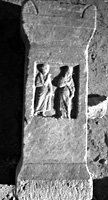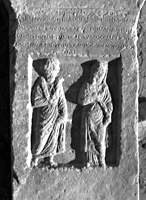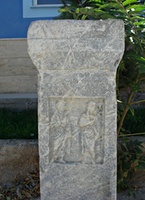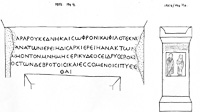 MAMA XI 345 (Savatra)
MAMA XI 345 (Savatra) 
Funerary bomos with inscription in verse
- Type of monument:
- Funerary bomos.
- Location:
- Yağlıbayat (Savatra): in the yard of the school.
- Description:
- Grey-blue marble bomos, complete. Inscription at the top of the shaft; below, recessed panel with two standing figures in relief. To the left, male figure in toga, standing in contrapposto with weight on left leg, right foot posed backwards as if walking. Right arm bent across the chest, resting in arm-sling of toga, with hand grasping the fold which is swung over the left shoulder. Left arm posed along the body, with hand grasping the loose fabric of the toga, pulling it tight over left leg. To the right, female figure in tunic and palla veiled over her head, standing in slight contrapposto with weight on right leg, left leg slightly bent at the knee. Right arm bent across the chest, resting in arm-sling of palla; left arm posed along the body, with hand grasping the fabric of the palla. Both faces damaged.
- Dimensions:
- Ht. 1.15; W. 0.44 (upper moulding), 0.37 (shaft), 0.44 (base); Th. 0.34 (upper moulding), 0.29 (shaft), 0.35 (base); letters 0.008-0.011.
- Record:
- Squeeze; line drawing; MB notebook copy; photographs (1956/194; CVC 2011).
- Publication:
- None.
- Date:
- First or second century AD.
〚 [- - - - - - - - - - - -] καὶ [- - - - - - - - - - - -]〛
[. . .]ΑΡΑΡΟΥ κεδνῇ καὶ σώφρονι καὶ φιλοτέκνῳ̣
[ἀθ]ανάτων ἱερείῃ δὶς ἀρχιερείῃ ἀνάκτων
[β]ωμὸν τὸν μνήμης ἐρικυδέος εἵδρυσε Βόκχ̣[ος]
5[εἶδ]ος τῶνδε βροτοῖσι καὶ ἐσσομένοισι πυθέ[σ]-
θαι.
[To (husband) and (wife)... ], diligent and self-restrained and a lover of her children, priestess of the immortals, twice high-priestess of the lords (i.e. the Augusti), Bocchus set up (this) bomos of glorious memory, so that even those mortals who are still to come may know the likeness of these (two).








The lettering and of the funerary relief are of unusually high quality for this region. The first line of the inscription appears to have been deliberately erased; the line would have included the names of the husband and wife honoured by this funerary epigram and depicted in the relief below. The letters ΑΡΑΡΟΥ at the start of line 1 are difficult. This could conceivably be the genitive of the wife’s father’s name; the name *Αραρος is not known elsewhere, but cf. Zgusta 1964: 88 §83-1 (Αραρα, well-attested in Isauria).
For the phrase ἀρχιερείῃ ἀνάκτων (i.e. civic high-priestess of the imperial cult) in line 2, compare TAM III 77 (Termessos), [ἀρχ]ιερῆα ἄνακτος ἀγα[κ]λ̣έος ἡ πατρὶς ἐσθλὸν τείμησεν. Another high-priestess of the imperial cult at Savatra is attested in Cronin 1902: 371-2, no. 144 (IGR III 1481: Ἀνχαρηνὴν Σακέρδωτος ἀρχιέρειαν Σεβαστῶν). The local priesthood of the imperial cult seems to have been the highest civic office in several cities of Lykaonia (Mitchell 1993: I 116-7); temples of the imperial cult are attested at the neighbouring cities of Kana under Trajan (MAMA VIII 211, with Mitchell 1993: I 97 n.185) and Perta under Hadrian (MAMA XI 309 [1956/169]).
In line 3, I have restored the name Βόκχ̣[ος], perhaps the son of the husband and wife commemorated here. The name is attested three times at Ankyra: I.Ankara: 8.34 (Bocchos son of Po[.]otios); 71 (C. Iulius Bocchos); 82-3 (Ti. Claudius Bocchos).
The verse in lines 4-5 concludes with the Homeric formula ἐσσομένοισι πυθέσθαι (H., Il. 2.119, 22.305; Od. 11.76, 21.255, 24.433), used to describe the funerary mound of Elpenor in Od. 11.75-6 (σῆμα τέ μοι χεῦαι πολιῆς ἐπὶ θινὶ θαλάσσης | ἀνδρὸς δυστήνοιο καὶ ἐσσομένοισι πυθέσθαι). The phrase was a popular one in funerary verse inscriptions of the Roman imperial period: cf. I.Klaudiu Polis 78; I.Beroia 400; Anderson 1899: 287, no. 185 (Kuyulusebil); Laminger-Pascher 1992: 190-1, no. 306, line 18 (Dineksaray).
The monument was still visible in the yard of the village school at Yağlıbayat in September 2010 and April 2011.